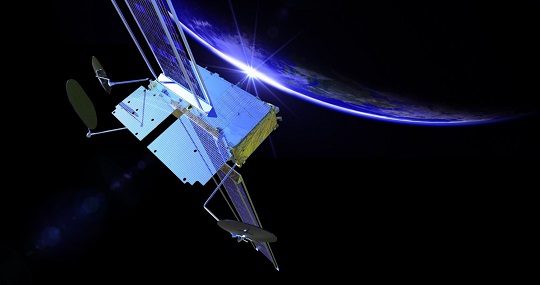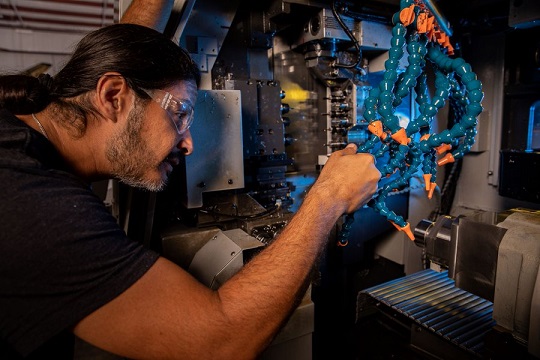 Supply chain disruptions have hit virtually every part of the satellite industry, forcing changes that may ultimately strengthen the industry. (Source: Kratos)
Supply chain disruptions have hit virtually every part of the satellite industry, forcing changes that may ultimately strengthen the industry. (Source: Kratos)
ALEXANDRIA, Va. — The space industry remains on a growth path despite ongoing supply chain challenges caused by the pandemic and geopolitical tensions.
While the difficulties are not isolated to one part of the industry, satellite manufacturers have been visibly adding floor space throughout recent economic disruptions.
Raytheon’s Blue Canyon Technologies unveiled an expanded manufacturing facility in Colorado along with plans for a 70% production increase in August. A month earlier, HawkEye 360 cut the ribbon on a 19,000-square-foot facility in Virginia to support its RF-sensing satellites. Aerospacelab recently unveiled its “megafactory” in Belgium with a production capacity of 500 satellites per year.
Governments and commercial partners are sending strong demand signals to the industry with estimates that the $35 billion global satellite manufacturing market remains on a positive growth trajectory.
Still, the trend toward “mass production” has been a good news, bad news story. On the one hand, demand is strong, launch costs have dropped dramatically and digital engineering, 3D printing and modular platform designs have streamlined production. On the other, the effects of global supply chain disruptions and soaring inflation have made it more difficult to access finished components and certain raw materials.
Building Stronger Supply Chains
In an industry defined by innovation, organizations have developed ways to cope with supply chain disruptions. Primarily, this has been through strengthening supply chain management processes and developing new sources or alternatives for hard-to-find components.
“There are things we have had to be much more purposeful about,” Chris Johnson, SVP of Space at Maxar told the 2022 World Satellite Business Week (WSBW) in Paris. Accounting for increased lead times, having multiple sources for supplies and building redundancy into supply chains can help ensure that a single component doesn’t “take a whole program down the wrong direction,” he noted.
Large and small satellite producers reported increased coordination with suppliers to stay alert to sudden changes. Most have expanded the number of suppliers they’re working with and have invested in alternative components. In addition to the pandemic, tensions with Russia and China have motivated multinationals to diversify the sources of materials and parts, while elevating the importance of supply chain integrity. Locking in design parameters has helped manufacturers establish predictability and many strategically buy components in bulk or as far in advance as possible.
 Satellite manufacturers are achieving production at-scale through state-of-the-art equipment, 3D printing and digital engineering. (Source: Sidus Space)
Satellite manufacturers are achieving production at-scale through state-of-the-art equipment, 3D printing and digital engineering. (Source: Sidus Space)
Computer-aided design has helped manufacturers model the effects of replacement components and more easily integrate alternative parts into platforms. While 3D printing has not reached the level of accuracy to build sophisticated semiconductors, the process is helping accelerate production.
Sidus Space, a satellite manufacturer and space-as-a-service provider, can produce its standardized LizzieSat buses in less than 30 days using in-house 3D printing and digital engineering. Sidus CTO Jamie Adams noted that “the increased automation with respect to printing and our ability to design and move that process along” had shortened the time to complete platforms.
Ultimately, the supply chain pressures will make the industry more resilient and adaptive in the future. Having to source and integrate a wider variety of components from different suppliers has helped companies stay on top of technology refresh, making it easier to identify new emerging technologies to build into constellations.
“Constantly refreshing technologies, that’s going to be the way of the future,” Adams said. “Honestly, I think that’s a good engineering process to begin with.”
Seeking Outside Help for Bulk Purchases and Inflation
While companies have been able to cope with certain supply chain disruptions, other issues have required a more comprehensive approach.
Semiconductors and microelectronics continue to be the toughest components to obtain and essential to any functioning satellite network—from space to ground, producer to end user. In the past two years, companies and governments have invested billions to increase domestic microchip production and lessen dependence on China. There are various estimates on how long the chip shortage will last. These range from early-2023 to 2025.
 Producers continue anticipating long lead times for microelectronic devices. (Source: C.Todd Lopez/JBSA)
Producers continue anticipating long lead times for microelectronic devices. (Source: C.Todd Lopez/JBSA)
Across the defense and aerospace industry, producers are experiencing unbearable wait times for microchips, including field programmable gate arrays (FPGAs). DefenseNews recently reported that L3 Harris had to buy back a batch of old radios it sold to a customer so it could reconfigure and reuse the FPGAs to meet demand for another order.
Despite being critical industries, space and satellite applications account for less than half a percent of the global semiconductor market.
During a WSBW panel, Airbus’ head of Space Systems Jean-Marc Nasr said that European primes had “started a discussion” with the European Space Agency (ESA) about forming a buying syndicate for satellite components—he did not specifically refer to microchips. According to Nasr, the ESA would assist with procurement for the entire industry, while individual companies would assume the market risk. There is no agreement currently, but Nasr argued it could strengthen the industry into the future and insulate it against geopolitical and other disruptions.
Persistent, high inflation across major markets is also creating a significant pain point for producers and consumers across the defense industrial base. In September, the U.S. Department of Defense released new guidance that gives contracting officers more flexibility to deal with the supply chain effects of inflation. The guidance is specifically aimed at small businesses and other suppliers who entered firm-fixed-price contracts before the onset of the current economic conditions. Other forms of relief are being explored.
Pushing Forward to Meet Demand
Virtually no one in the satellite industry has been spared the effects of the supply chain disruptions. In interviews and conversations with Constellations, producers described lead times of one to two years for certain components. According to one production manager who spoke to Constellations on background, the era of just-in-time customer fulfillment is over—at least for now. “After COVID,” he said, “there are no more miracles.”
At the same time, government customers are increasingly looking to buy products and services at scale. Earlier this year, the Space Development Agency announced awards for 126 communications and missile tracking satellites. According to The Space Foundation, governments around the world have increased spending on military and civil space programs by 19% over the last year.
Euroconsult projected up to 17,0000 new satellites will be deployed in the next decade, a fourfold increase over the last ten years. Governments will make up a large portion of these launches, as well as new LEO operators. Manufacturers have noted greater interest in recent years from nontraditional players seeking to own and operate their own constellations—this includes agricultural firms, urban planners as well as insurance and financial services.
This growing demand for satellite capabilities and services only underscores the importance of stable, resilient and transparent supply chains in meeting expectations and pushing the entire industry forward.
Explore More:
Podcast: Space-as-a-Service and 3D-Printed Satellites
Affordability Is Transforming the Satellite Industry
A Space Renaissance Born of a Thriving Ecosystem
